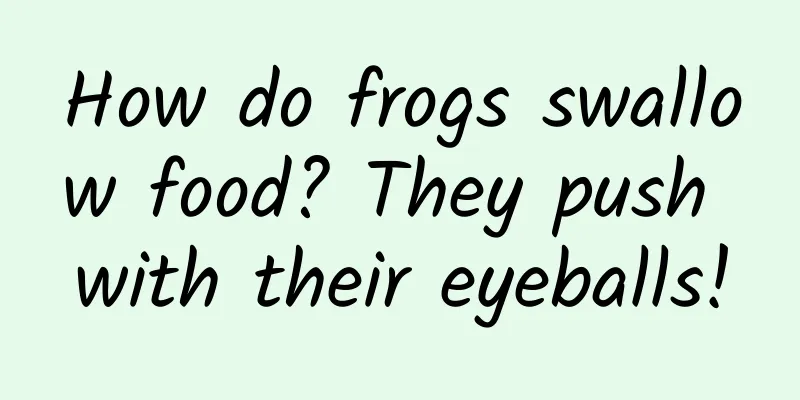How do frogs swallow food? They push with their eyeballs!

|
Editor’s Note: After the comprehensive science exam, a physics question became a hot topic, and a little frog catching insects in a rectangular coordinate system became popular. According to netizens, in this question, the frog and the insect move in the coordinate system separately, and the frog can only eat the insect when the frog and the insect intersect. No No No, you who made the question really underestimated the frog. If the frog wants to eat the bug, it doesn't need to interact with the bug. Its tongue is not grown for nothing! Capture! | Rachael Lallensack / Science A few years ago, Alexis Noel, who had just started her doctorate at Georgia Tech, made a strange request to the students in an anatomy class: After they had cut up a frog, could they give her the tongue? The students agreed. Noel holding a toad in the lab|Alexis Noel Move out! Super strong predatory tongue! Noelle has loved frogs since she was a child, and when she joined David Hu's biomechanics lab, she couldn't wait to study them. Hu Lide is also very interested in this topic. Not long ago, he visited the Atlanta Botanical Garden and saw a group of colorful poison dart frogs eating. He saw a miracle of physics in the movements of these frogs: when they ejected their sticky tongues at insects, their speed and precision were amazing. He later filmed a leopard frog with a high-speed camera and found that it could catch insects in less than 0.07 seconds - five times faster than the blink of an eye. When its tongue hits its prey, its acceleration is 12 times that of gravity. Yet somehow, the prey is not knocked away, but stuck to its tongue. Giant leaf frog (Phyllomedusa bicolor) hunting|Ed Yong / Youtube You can try to design a wet material that will hit a rough textured object at high speed and stick to it. You can't design it. No one has ever done it. Yet frogs perform this feat every time they hunt. People have studied frog tongues since the 1800s, but until now, we still haven't figured out why they're so sticky. Why is it so sticky? To answer that question, Noel collected frog tongues from anatomy classes. Then, in the grand tradition of naturalists, she poked them with her fingers. She and Hullid were amazed at how soft they felt. “They were like silly putty, and you couldn’t tell if they were solid or liquid,” Hullid said. “They were also very sticky, like freshly chewed gum or marshmallows that stuck to your hand.” Noelle then walked into a materials testing lab with a bag of bloody frog tongues and human tongues collected from the school’s body farm. By slowly pressing a cylinder into the excised organs, she proved that human tongue is ten times tougher than frog tongue. Not only that, the tongues of some frog species are among the softest of all biological materials ever measured by humans. "They are as soft as the human brain - but the human brain does not pop out to catch prey," said Hu Lide. Because of its softness, the frog tongue can wrap around the insect when it hits it, creating the largest contact surface. Kurt Schwenk of the University of Connecticut also pointed out: "The inertia of the frog tongue itself allows it to extend significantly during the popping process, which increases the predation distance of frogs and improves their ability to attack insects." The frog tongue also has built-in shock absorbers—a bit of fat and muscle that absorbs some of the energy during an impact. These shock absorbers come into play when the frog tongue retracts: The insect is subjected to a lot of force, but it doesn't fall off. "The tongue is like a trampoline with a baseball glove—it stretches and retracts, but it also grabs you," Hu said. Frog tongue stretching experiment | Ed Yong / Youtube "We know that leopard frogs prey on a wide variety of insects, earthworms, and other invertebrates," said Jenna Monroy of the Claremont Colleges. "They may be able to adjust the stiffness and resistance of their tongue to the size of their prey to ensure successful capture." "But this soft tissue is only half the battle," Noel said. The other half is the frog's saliva. She and her colleagues spent a lot of time and effort to scrape the saliva from the frog tongues they collected. "The saliva is very sticky, and you have to scrape it off the scraper every time you scrape it," Hu Lide said. "It takes half an hour of hard work to collect half a milliliter. It's like a rare treasure." Captured Again! | David Shultz / Science "People used to think frog saliva was just viscous," Noel said. But after careful study, she found that the saliva is a non-Newtonian fluid - a type of liquid whose properties change depending on the force applied to it. For example, honey changes from solid to liquid when stirred, a mixture of corn starch and water becomes solid when tapped, and ketchup becomes more fluid when the bottle is shaken. Saliva is like ketchup: external forces reduce its viscosity. But when subjected to the same external force, the viscosity of human saliva drops to about 1/10, while the viscosity of frog saliva drops to about 1/100. So when the frog's tongue hits the insect, the saliva on it begins to flow freely and easily seeps into every crack and opening on the insect's body surface. And when the tongue slows down and retracts, the saliva recondenses into a sticky state, which is equivalent to a clenched fist, grabbing the insect back. What if food gets stuck on your tongue? "This analysis could help explain many of the interesting things we observe, such as why frogs use the back part of their eyeballs to push prey down their throats." Once the insect is in its mouth, the frog has to get it off its tongue, says Kiisa Nishikawa of Northern Arizona University. Luckily, all of its mucus tricks work best in the vertical direction; it's hard to pull an insect off its tongue, but easier to pry it off. The frog just needs something to push the insect away - so it uses its eyeballs. Twelve years ago, Robert Levine showed with X-ray video that frogs pull their eyeballs inward as they swallow, and use them to push insects off their tongues. Horned frogs use their eyes to help swallow prey|Ed Yong / Youtube Sticky animals are the muse of materials science! Many studies of sticky animals have led to new materials. Geckos’ wall-climbing abilities led to the development of dry adhesives; mussels’ byssus (webs of sticky fibers that secure them to rocks) inspired a glue that can be used underwater; and worms have led to a better medical tape and a glue that doesn’t bleed, allowing wounds to be repaired without stitches. Who knows what inventions frog tongues will lead to? "Imagine a suture that hardens immediately after a quick application," Hu said, "or a Band-Aid that doesn't hurt when you remove it quickly." "Why should we care about these things?" said Nishikawa, who studies animal mechanics. "Because inspiration from biology can solve practical human problems. Frog tongues may seem unpopular, but don't forget that antibiotics also come from bread mold." I just wanted to suck a cat while I was studying! |JENNIFER VIEGAS / Reader's digest Now, Noelle has turned her attention to cat tongues. They are covered in a blanket of tiny spines. Noelle wonders if this structure is for grooming, picking meat off bones, or some other purpose. "I've studied the tongues of both house cats and tigers," she says. "Cats and frogs are both animals I love and I'm currently studying them. It's a beautiful life." By Ed Yond Translation: Porco Rosso This article comes from the Species Calendar, welcome to forward If you need to reprint, please contact [email protected] |
<<: How to save yourself when facing a fire?
Recommend
Why are 1 to 0 read as “一两三四五六拐怕勾洞”?
When watching war movies, you must have heard the...
Cucumbers are obviously green, so why are they called cucumbers?
This article was reviewed by Sun Hai, a plant sci...
Douyin monetization promotion, 7 ways to make money on Douyin!
2018 may be the year when everyone tried out TikT...
SMMT: UK new car registrations fell 34.9% in June 2020
According to data released by the SMMT, new car r...
Practical Tips丨A review of the four creative points in financial management advertising
According to the industry delivery report previou...
Why do I often have bruises on my body?
Expert of this article: Fang Jie, Associate Chief...
How to achieve the best ROI in Yidian Zixun information flow advertising?
Information flow advertising has become the new f...
Why are all the ads I see on TikTok games?
Capture SSS-level Lingkun at the beginning, 5th t...
Grand Central Dispatch Tutorial
In the first part of the tutorial, you learned so...
Lenovo YOGA S730: All-aluminum body shows exquisite texture, Intel 8th generation CPU makes work more efficient
When laptops were first introduced, portability s...
8 ways to teach you how to operate KOL
I used to be a community operator , and at that t...
Low Earth orbit space is a "big treasure"
Not long ago, after the successful launch of the ...
How to monitor website conversion rate?
The conversion ability of a website mainly refers...
Is the biggest blunder in Samsung’s history an opportunity for Lee Jae-yong?
On October 10, Lee Jae-yong, the third-generation...
Wine and coffee, I just want one glass ~ Scientists: You are right, you should quit drinking!
Produced by: Science Popularization China Author:...









